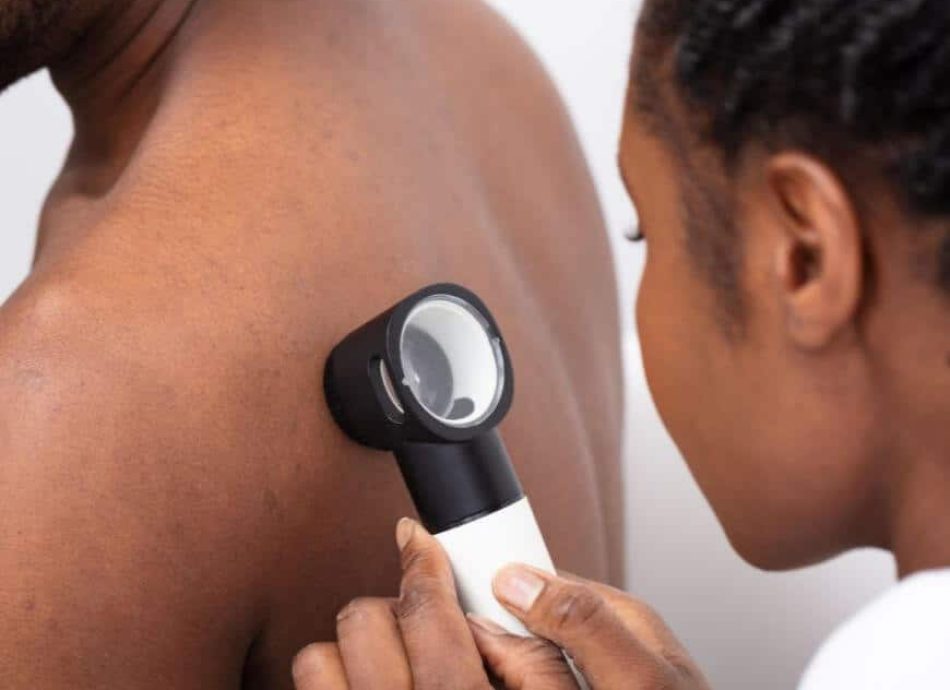Award winning dermatology service, with over 20 years of experience
Short waiting lists, on some occasions offering same week appointments
Safe environment, in Care Quality Commission approved facilities
photodynamic therapy manchester
Photodynamic Therapy (or ‘PDT’) is a treatment using specially formulated topical products and light therapy used to help rid the body of some cancerous and precancerous lesions. Cosmetically however, PDT works by destroying abnormal or damaged cells which have resulted in all sorts of pronounced skin problems.
It’s primarily used for treating skin lesions both cancerous and pre-cancerous. A simple two-step process that harnesses light energy to activate chemicals to create reactions that cause the death or damage of cells, the process uses a photosensitising cream which activates when it’s illuminated with a specific wavelength of light. Photo Dynamic Therapy was first cleared by the FDA for the treatment of skin lesions in 2004 although we still consider it a new treatment.
This treatment is a modern technique used because it offers an effective localised solution to remove lesions. As a result, it does not cause damage to the skin in the surrounding area or scaring. Furthermore, there is no need for anaesthetic and the recovery is fast.
HOW DOES PHOTODYNAMIC THERAPY WORK?
The treatment works by applying a topical cream, which is light sensitive, to the lesion and then using a light source, artificial or natural, to destroy any abnormal cells. On their own, both the cream and the light are harmless, but when exposed to light the cream causes a reaction that damages nearby cells.
During your procedure, sunscreen of an SPF of 30 or higher will be applied to the treatment area, which protects your skin. Your lesion is then prepared by cleaning the surrounding skin and removing any crusting. The topical cream will then be applied and will be left to fully absorb and build up in the abnormal cells. The light treatment will then begin which is either administered through a lamp or a laser for a short time, or you will be exposed to the daylight for a couple of hours.
The main side effect of the treatment is that you may experience mild tingling or pain in the treated area. This can be reduced by the use of a water spray to soothe any feelings of discomfort.
During your consultation at Everything Skin Clinic, your consultant dermatologist will assess your condition and discuss the most appropriate treatment options for you.
USING PHOTODYNAMIC THERAPY TO TREAT SKIN CANCERS
Photodynamic Therapy successfully treats Non-melanoma skin cancers these include (BCC) Basal cell carcinoma and (SCC) Squamous cell carcinoma in situ or Bowen’s disease. BCC affects cells in the basal layer of the epidermis.
PDT is a highly effective treatment for treating some pre-cancerous skin lesions such as actinic keratosis and Bowen’s disease. These lesions are skin irregularities which have a risk of developing into cancer. Using the localised Photodynamic Therapy, we first apply a photosensitising agent to trigger a chemical reaction in the skin using red light.
BOWEN’S DISEASE
Bowen’s disease is a common slow-growing pre-cancerous skin lesion, it can be mistaken for psoriasis or eczema. Often, it’s a red scaly patch on the skin. Left untreated these lesions can develop into Squamous cell Carcinomas (SCC).
ACTINIC KERATOSIS (AK)/ SOLAR KERATOSIS
Scaly lesions are commonly found on sites which are more exposes to the sun such as the face (Ears nose upper lip) and hands. They are common on the scalp is bald areas. Less commonly they are also found on the trunk, back lower limbs and feet. Lesions like these can develop into Squamous (SCC). Any changes in thickness ulceration or development of these lesions.
BASAL CELL CARCINOMA (BCC)
BCCs (also known as rodent ulcers) are a type of skin cancer that either takes the form of a single bump or a series of small bumps. Multiple lesions are sometimes found in the same patient. This type of skin cancer rarely spreads to other parts of the body, however, early treatment is recommended because, if ignored, the tumour can enlarge and become locally invasive.
ACTINIC CHEILITIS
Actinic Cheilitis is a lesion that develops on the lip it looks like chapped lips and can become scaly and white. Although it’s not painful, there is a risk it can develop into SCC. A lesion can go away by itself but can reoccur and it is common to see more than one lesion at the same time. Lesions sizes and colour vary. There are a range of treatments offered and treatment using PhotoDynamic therapy is effective to eradicate these lesions.
PHOTODYNAMIC THERAPY CAN ALSO TREAT:
FACIAL REJUVENATION
Since the development of PhotoDynamic Therapy for facial rejuvenation has developed from the treatments of skin lesions. This treatment uses specific chemical-based products which activate in the skin using light to boost the production of new skin cells. As a result, it creates a more youthful appearance of the skin. Treatment is effective in treating sun-damaged skin helping to remove pigmented lesions and improve the condition and elasticity of the skin.
ACNE TREATMENT
PhotoDynamic Therapy is becoming a much more widely accepted treatment for forms of Acne. Results have shown to be highly effective for patients where other treatments have not been successful. This non-invasive treatment helps the condition by shrinking and destroying the oil glands that produce oil. PDT can also kill the bacteria responsible for causing the spots. When PhotoDynamic Therapy is the treatment of choice for acne, we may combine this with other treatments for maximum results and we will discuss this during your consultation if needed.
FREQUENTLY ASKED QUESTIONS
WHAT IS THE DIFFERENCE BETWEEN PHOTODYNAMIC THERAPY AND DAYLIGHT PHOTODYNAMIC THERAPY?
The only difference between these two treatments is the light source that is used. In Photodynamic Therapy, an artificial light in the form of a lamp or a laser is used. In Daylight Photodynamic Therapy, the light source is natural daylight.
HOW LONG DOES IT TAKE TO RECOVER FROM PHOTODYNAMIC THERAPY?
Most people can carry on with normal activities 24-48 hours after treatment. The key thing is to avoid direct sunlight during this time as you may be more sensitive to light. You will gradually become less sensitive to light and things will return to normal.
DO I NEED TO PREPARE FOR PHOTODYNAMIC THERAPY?
It is recommended that you cover up on your way home from the treatment to avoid sunlight as much as possible. If the treatment is on your face, it is a good idea to bring a hat, scarf or sunglasses. If the treatment is on your body, wear clothes which will cover any exposed skin.
HOW DOES PHOTODYNAMIC TREATMENT WORK?
INDIVIDUAL LESIONS
We will first prepare the lesion by removing the built-up skin cells, removing crusts and accumulated debris. Cream is then applied to the lesions and the area next to it, and a dressing which you must remove or disturb. This stays in place for 3 hours. After 3 hours, we will remove the dressing, position the light and apply this for around 8-10 minutes. During this, we will provide goggles to protect the eyes.
LARGE AREAS, REJUVENATION OR ACNE
To prepare the skin, we will first clean the skin, and then we will remove any built up excess skin cells to allow the products to penetrate the skin. Next, we apply a special gel to the treatment area which is then covered with a dressing. This should stay in place for 3 hours allowing the products to penetrate into the skin. It is important to protect the skin from direct sunlight and cold during this time. Once the skin has absorbed the gel, we will remove the dressing will and you will lay down with your eyes protected whilst we apply the light. The amount of time will depend on the intensity of the light delivered as the treatment requires a specific dose. Following treatment, we will remove the gel, and apply sunscreen for protection. After PhotoDynamic therapy, you will generally require at least two follow up sessions spaced 1 week apart.
Aftercare advice:
• Keep the treatment area clean and dry for 24 hours
• Use the skincare recommended for you at the consultation.
• Take paracetamol can for any pain.
• Protect the treated area from the sun for 2 days
• Use a protective sunscreen as advised by your dermatologist
REQUEST A CALL BACK
Please fill in this form and one of our team will give you a call back to arrange a consultation with one of our expert dermatologists.
"*" indicates required fields

HEAR FROM OUR PATIENTS
WHY HAVE photodynamic therapy in manchester AT EVERYTHING SKIN CLINIC?
At Everything Skin Clinic™, we have a team of highly trained Consultant dermatologists, who have completed specialist training in Dermatology and are on the specialist register of the General Medical Council. All our consultants hold substantive contracts with the best Dermatology centres in leading NHS hospitals. Therefore, you can be certain of the highest quality private care.
We offer a range of treatments and can offer one, or a combination of treatments to achieve the best results. Unlike many other clinics, we can offer diagnosis and treatment all under one roof by expert consultant dermatologist, so you know you’ll be in safe hands.
INSIGHTS AND ADVICE

A Complete Guide to Protecting Your Skin – Understanding SPF
Unlocking the Power of Sunscreen The SPF tag on skincare products can seem bewildering, particularly if you’re new to skincare. But don’t worry, we’re here to help. This detailed guide will delve into the importance of SPF in skincare, choosing the correct SPF, and seamlessly

Demystifying Varicose Veins: Identifying, Controlling And Avoiding
Varicose veins appear as tangled, swollen veins that can mar the beauty of your legs and result in discomfort. These veins are a prevalent issue, particularly as we age. Unpacking the intricacies of varicose veins is key to managing and possibly mitigating their complications. Within

Unmasking Acne: A Thorough Examination for Acne Awareness Month
Acne Awareness Month is globally recognised in June. It serves as an occasion to highlight one of the most prevalent skin conditions across the globe, emphasising the significance of education, assistance and available treatments for individuals dealing with acne. The aim of Acne Awareness Month




